ATK and NASA Report Initial 30-Day Findings from Development Motor (DM-2)
Share:
Data Confirm ATK Five Segment Solid Rocket Motor is Ready for Flight Testing
Five-Segment Design Matures to Support Future Launch Vehicles with Significant Performance Improvements at Reduced Cost
PROMONTORY, Utah - Data from the second successful five segment Development Motor (DM-2) test conducted by ATK (NYSE: ATK) and NASA show that the new motor performed precisely as designed, providing substantially higher performance and reliability than the heritage space shuttle solid rocket booster at a lower cost.
"These extensive test results confirm the ATK five segment Solid Rocket Motor (SRM) is ready for flight testing," said Charlie Precourt, vice president and general manager of Space Launch Systems, ATK Aerospace Systems. "The five-segment first stage design was based on more than 30 years of safety-driven improvements on the shuttle program. The result is a higher performing, more reliable solid rocket motor, which equates to increased safety for crew and mission success for cargo."
The 30-day findings from the August 31 ground test were compared to data collected from the first ground test (Sept. 2009) and the Ares I-X flight test (Oct. 2009) to develop a greater understanding of motor and material performance and first stage avionics. The data were also compared to ground test, flight, and post-flight data collected throughout the Space Shuttle Program.
Modifications to the motor include an added fifth segment, changes to the propellant grain, a larger nozzle opening, and an upgraded liner and insulation -- all designed to meet performance requirements and increase reliability while lowering manufacturing costs.
"We were able to incorporate many design changes during the five-segment development that we identified during the shuttle program but were not able to make given the shuttle vehicle's operations tempo," said Precourt. "We also incorporated materials and streamlined processes that have been flight-proven in our commercial programs."
Propellant grain changes included an additional fin to provide the necessary thrust profile at liftoff and changes to propellant angles at joints to increase structural safety factors. The ballistics data from DM-2 were exactly in line with predictions.
The new insulation and liner is made of environmentally-friendly material that replaces the obsolete asbestos-based insulation used on shuttle. Advantages include improved thermal properties and lower density, offering 10 percent or 2,000 pounds in weight savings, which allows for heavier payloads. Process improvements developed with the new green material have also yielded safety and schedule benefits. Results from DM-2 showed the new liner provided higher thermal protection than the shuttle motors.
New low-temperature O-rings enabled the elimination of joint heaters and the associated cabling and infrastructure. This lowers joints complexity, thereby eliminating additional failure modes, and saves 500 pounds in weight, while providing a stronger seal than previous O-rings.
A main objective of DM-2 was to test the new O-rings at cold temperatures. The motor was conditioned to approximately 40 degrees F., and flaws were introduced into the joints that allowed hot gases to potentially penetrate the insulation into the joint and thermal protection system where the O-rings are housed. Even under those conditions, the seal and thermal protection system on DM-2 performed as designed.
"We are very pleased with the initial data collected from DM-2," said Precourt. "It shows the performance of the motor and components either met or exceeded our predictions."
Thrust oscillation is another area where DM-2 results are significantly better than initial models predicted. Through combined DM-2, DM-1 and Ares I-X results, and with computational fluid dynamics analyses, NASA and ATK engineers have learned the behavior attributed to thrust oscillations in five-segment solid rocket motors is 30 to 60 percent less than previously predicted. Specifically, the DM-1 and DM-2 data indicate that this motor is very quiet, producing very low pressure oscillations. Also Ares I-X showed that in flight, the overall structure of that configuration is less susceptible to excitation than previously expected.
The technical and material improvements to the motor, combined with new tools and streamlined processes, have enabled ATK to produce motors at a lower cost.
As the prime contractor for the five-segment motor first stage, ATK continues to perform on schedule and within cost to support NASA's space exploration programs. ATK is currently maturing the first stage avionics, and will complete a critical design review in the fall of 2011.
ATK is a premier aerospace and defense company with operations in 24 states, Puerto Rico, and internationally, and revenues of approximately $4.8 billion. News and information can be found on the Internet at www.atk.com.
SOURCE ATK
CONTACT: media, Trina Patterson, +1-801-699-0943, trina.patterson@atk.com,
Web Site: www.atk.com




